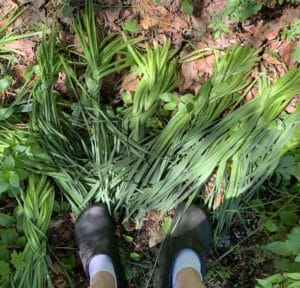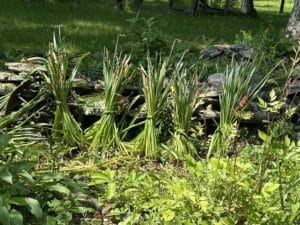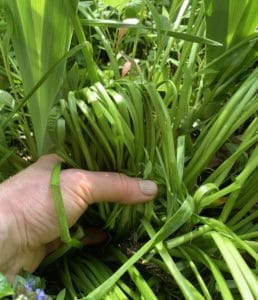Hello, fellow lovers of all things green.
At last, I had some time in my garden. Not much time, but any time brings such joy. Though true, I get overwhelmed at how many things need addressing. Then came a quick fix to the overwhelming feeling—tidying daffodil foliage.
As much as I love the happy faces of the daffodils gracing the gardens after the flowers fade and the foliage begins to flop, well, they’re not pretty. I inherited several daffodils from the previous owner, but I especially adore the many lovelies my dear friend and design colleague, Marty Carson, gave me. More than that, the plant knowledge she generously shared in the 23 years we’ve worked together continues to grow in my clients’ gardens—I am so grateful.

Loose braids are my go-to way to tidy flopping daffodil foliage.

Then there’s the Ponytail Technique.
Marty’s Lovely Lineup of Daffodils:
From small ones such as ‘Tete-a-Tete’ to taller ones such as ‘Thalia,’ which are fragrant, all white, with multiple blooms on one stem. The all-yellow Narcissus’ February Gold’ is one of the earliest daffodils to bloom, about the same time as the not-so-common Iris reticulata – a tiny, fragrant iris in glorious blues, white and yellow. Then there’s the later white blooming Poet’s Daffodil’ Pheasant’s Eye’ with little orange centers. (Links to the lovelies below.)
Allow Daffodil Foliage to Fade
Allowing daffodil foliage to fade is vital to ensuring next year’s blooms. One fall, I planted a hundred daffodils for a couple who only spent weekends in their Stillwater home.
“I had many daffodils in the lawn, but they’re mostly gone now,” Ron said.
I suggested we plant new bulbs above their rock wall, choosing the above-mentioned assortment of daffodils (Narcissus) to offer blooms from early to late spring.
During the early spring, I dropped by to check on Ron’s gardens. As if a mother were waiting, it was thrilling to find some of the new bulbs had bloomed and many others were about to. Then, during a second stop a few weeks before Memorial weekend, I found all the daffodil foliage weed-whacked down by the lawn service. I’m sure in the spirit of tidying up, not knowing the importance of leaving the foliage standing until it begins to turn yellow, about six weeks after the flowers are spent.
Per the American Daffodil Society, “leaves removed soon after flowering by mowing or cutting back can severely deplete your bulbs.” Mystery solved as to why Ron’s original daffodil population depleted.

Then there’s the tie-a-knot with a clump of leaves technique.

… or the fold-over-like folding socks technique.
Stylish Ways of Tidying Daffodil Foliage
While you can just let the fading daffy foliage lay, there are tying-up techniques to tidy the foliage. My favorite is loosely braiding the leaves, which reminds me of my long-braided locks as a kid. I recently learned you can take one long leaf and wrap it around a clump of others a few inches above the ground to create a standing ponytail. How fun it is to style the garden with braids and pigtails!
Then there’s the tie a knot with a clump of leaves, making a donut-looking thingy in the garden. Or the fold-over-like folding socks technique securing it with a loose rubber band or twine. If you tie too tightly, the foliage will be restricted from air circulation and sunlight to photosynthesize, lessening the blooms next year. So, tying the fold-over with a few daffodil leaves may be safer. And more stylish. Not to be confused with a comb-over fellas. Just saying.
So, after planting the potted gardens with herbs mixed with annuals, I tiptoed amongst the daffodils in the afternoon drizzle and played hairstylist. Braids and ponytails now adorn the garden, giving me a sense of accomplishment while providing the daffys time to go dormant. Plus, I twisted a few donuts and folded a few socks just for fun. Let’s all take time to play in this garden of life.
Garden Dilemmas? AskMaryStone@gmail.com and your favorite Podcast App.
There’s more to the story in the Garden Dilemmas Podcast:
Related Post and Podcast:
Ep 81. Bulbs Extending Blooms & Deterring Squirrels
Bulbs to Extend Spring Blooms – Blog Post
Marty Carson’s Lineup of Lovlies: Narcissus ‘Tete-a-Tete,‘ ‘Thalia,’ ‘February Gold,’ and ‘Pheasant’s Eye’ plus Iris reticulata.


